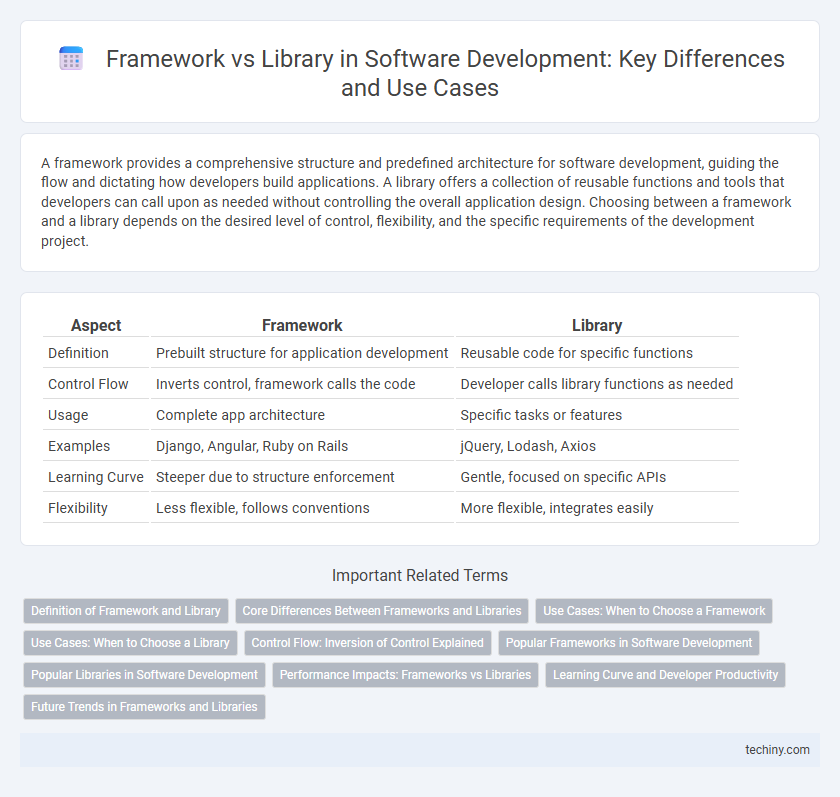A framework provides a comprehensive structure and predefined architecture for software development, guiding the flow and dictating how developers build applications. A library offers a collection of reusable functions and tools that developers can call upon as needed without controlling the overall application design. Choosing between a framework and a library depends on the desired level of control, flexibility, and the specific requirements of the development project.
Table of Comparison
| Aspect | Framework | Library |
|---|---|---|
| Definition | Prebuilt structure for application development | Reusable code for specific functions |
| Control Flow | Inverts control, framework calls the code | Developer calls library functions as needed |
| Usage | Complete app architecture | Specific tasks or features |
| Examples | Django, Angular, Ruby on Rails | jQuery, Lodash, Axios |
| Learning Curve | Steeper due to structure enforcement | Gentle, focused on specific APIs |
| Flexibility | Less flexible, follows conventions | More flexible, integrates easily |
Definition of Framework and Library
A framework in software development provides a structured foundation and predefined architecture for building applications, often enforcing specific design patterns and workflows. A library is a collection of reusable functions or modules that developers call upon to perform specific tasks without dictating the overall application structure. Frameworks control the flow of an application, while libraries offer targeted functionality that developers invoke as needed.
Core Differences Between Frameworks and Libraries
Frameworks provide a structured foundation that dictates the flow of an application through inversion of control, requiring developers to follow predefined patterns and contribute custom code within the framework's architecture. Libraries offer reusable functions or modules that developers call explicitly to perform specific tasks without dictating the overall application design or control flow. This fundamental distinction in control flow and architectural influence distinguishes frameworks as comprehensive blueprints, while libraries serve as flexible, specialized toolkits in software development.
Use Cases: When to Choose a Framework
A framework is ideal for complex software projects requiring a structured architecture and consistent design patterns, such as enterprise applications and large-scale web development. It offers built-in features like routing, state management, and templating, making it suitable for scenarios where rapid prototyping and maintainability are priorities. Choosing a framework enhances team collaboration and code scalability by enforcing standardized development practices.
Use Cases: When to Choose a Library
Choosing a library is ideal for specific, focused tasks where developers need to add particular features without altering the overall application architecture. Libraries offer greater flexibility by allowing selective function calls, making them suitable for projects requiring modular or incremental enhancements. This approach is effective for integrating user interface components, data manipulation utilities, or networking functions without enforcing structural constraints.
Control Flow: Inversion of Control Explained
Frameworks impose Inversion of Control (IoC) by dictating the program's flow and calling user-defined code at specific points, ensuring a structured development process. Libraries, in contrast, offer reusable functions or classes that the developer calls explicitly, maintaining control over the application's execution sequence. Understanding this key difference helps developers decide between frameworks that provide an architectural skeleton and libraries that enhance functionality without restricting control flow.
Popular Frameworks in Software Development
Popular frameworks in software development such as React, Angular, and Vue.js provide comprehensive structures that facilitate building scalable and maintainable web applications by defining the flow and architecture. Unlike libraries, which offer specific functionality like data manipulation or UI components, frameworks control the overall application design and enforce coding conventions to ensure consistency. Developers often choose frameworks like Django for Python or Ruby on Rails for Ruby to leverage built-in features that streamline backend development and reduce boilerplate code.
Popular Libraries in Software Development
Popular libraries in software development such as React, Lodash, and Axios provide developers with reusable functions and components to streamline coding tasks, enhance functionality, and improve application performance. These libraries focus on solving specific problems or adding particular features, offering flexibility without imposing a strict structure on the project. Compared to frameworks, libraries allow developers to retain full control over the architecture while leveraging optimized, community-tested code for rapid development.
Performance Impacts: Frameworks vs Libraries
Frameworks often impose a predefined structure and handle more control flow, which can introduce overhead and impact application startup time and runtime performance. Libraries provide focused, reusable functions without enforcing architecture, allowing developers more flexibility to optimize performance-critical code paths. Choosing between frameworks and libraries requires evaluating the trade-off between development speed and the potential for fine-tuned performance optimization.
Learning Curve and Developer Productivity
Frameworks typically have a steeper learning curve due to their comprehensive structure and enforced design patterns, requiring developers to understand the framework's conventions before effectively using it. Libraries offer more flexibility with a gentler learning curve, allowing developers to integrate specific functionalities without adopting an entire architectural style. Choosing between a framework and a library impacts developer productivity by balancing initial setup time against long-term maintainability and scalability within software projects.
Future Trends in Frameworks and Libraries
Future trends in software development highlight the growing adoption of modular and micro-frontend frameworks, enabling more scalable and maintainable architectures. Enhanced AI-driven code generation and automation tools are increasingly integrated into libraries and frameworks to streamline development workflows. The evolution towards cloud-native frameworks supports seamless deployment and scalability, aligning with DevOps and continuous delivery practices.
Framework vs Library Infographic

 techiny.com
techiny.com